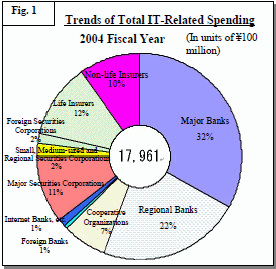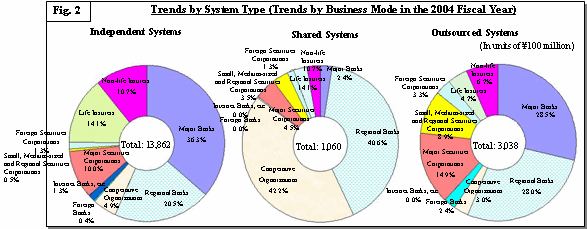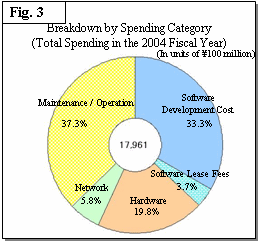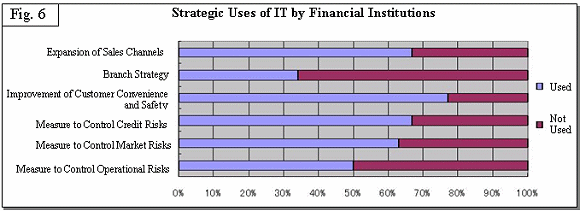| |
(i) |
Overall Picture of IT Spending among Financial Institutions
 Fig. 1 presents the total picture of IT spending by Japanese financial institutions as of the end of the 2004 fiscal year. Fig. 1 presents the total picture of IT spending by Japanese financial institutions as of the end of the 2004 fiscal year.
It shows that Japanese financial institutions' IT-related spending totaled approximately ¥1,800.0 billion as of the end of the 2004 fiscal year. By business mode, the total is broken down to slightly over 30% spent by the major banks, slightly over 20% by regional banks, and approximately 10% each by major securities corporations, life and non-life insurance companies, and cooperative financial institutions.
The graph in Fig. 2 breaks down the total IT-related spending among independent systems, shared systems and outsourced systems. It shows that spending for independent systems amounted to approximately 75% of the total, representing the largest spending segment. It also shows that spending for shared systems was made mainly by regional banks and cooperative financial institutions, although the total amount of such spending represented only a small portion of the total spending. |
| |
(Note) Independent systems refer to systems that are developed, purchased or leased independently by individual financial institutions. Shared systems are business systems that are jointly developed and run by multiple financial institutions. Outsourced systems are systems that are outsourced to vendors (including those that are developed, as well as maintained and run, by vendors). |
 |
| |
 Fig. 3 shows the trends of IT-related spending among five spending categories, consisting of software development cost, software lease fees, hardware, network, and maintenance/operation. The graph shows that spending for maintenance and operation represents the largest spending category. Fig. 3 shows the trends of IT-related spending among five spending categories, consisting of software development cost, software lease fees, hardware, network, and maintenance/operation. The graph shows that spending for maintenance and operation represents the largest spending category.
By business mode, major banks, major securities corporations, and life and non-life insurers were found to have spent substantially on software development whereas regional banks and cooperative financial institutions spent a great deal for hardware and networks. |
(ii) |
Current Status of IT Use, Issues and Areas of Future Efforts, Viewed in Terms of its Cost vs. Effect
Next, a summary of the results of a survey on the current status, issues and future areas of efforts with respect to the way IT is used, based on the perspective of cost vs. effect is introduced by breaking down the process into the following phases: planning/design, procurement, development, maintenance/operation and post-spending evaluation.
Fig. 4 shows the results of a survey on the question of whether or not financial institutions set their IT investment strategies and goals with respect to the effects of their IT investment. The figure reveals that more than 70 percent of financial institutions set strategies for investment in IT, but only approximately half of them established goals for the effects. Regarding the question about ''issues that planning and design face,'' many responded with such answers as ''It is difficult to tell whether the effects of investment are reasonable. (There is no objective external criteria that can be used to evaluate one's company's investment decisions.)'' On the other hand, financial institutions that already had set goals for effects gave such comments as the following: ''Such indicators as ROI, ROA, ROE, internal rate of return, break-even point, net present value, etc. are used as quantitative targets,'' ''Investment projects are classified into four categories (maintenance of status quo, quality improvement, cost reduction, and profit improvement) and expected effects (financial effects, non-financial effects, opportunity loss prevention effects) are established on a category by category basis.''
|
 |
| |
In the ''procurement'' phase, nearly all financial institutions, regardless of their business modes or sizes, responded that they considered ''cost'' to be important when they were asked about ''important factors to consider when making procurement decisions (multiple answers were permitted).'' On the question of ''efforts to reduce cost when making purchases (multiple answers were permitted),'' answers included ''extensive use of competitive bidding'' (52%), ''purchase of systems that are used by many other companies'' (39%) and ''surveys of other companies in the same industry'' (38%). (The figures in parentheses are percentages of financial institutions that picked respective answers. The same applies in the remainder of this section.) Regarding ''specific issues faced in procurement,'' a number of respondents stated that ''verification of the reasonableness of development man-hours, price, contents, etc. is not possible, due to the fact that systems have been turned into black boxes.''
In the ''development'' phase, on the question of ''efforts to control the development process'', answers included ''periodic reporting to the executive board'' (61%), ''establishment of project control rules'' (45%) and ''introduction of project management tools'' (20%). About ''specific issues experienced in development,'' answers included the following: ''System development has been implemented on a system by system basis under various design concepts instead of taking the concept of overall optimization into consideration. This resulted in high development and maintenance costs and rigidity to change.'' ''Professionals who have expert knowledge and those who have the skills of project management are in short supply or becoming older.'' On the other hand, responses also provided such success stories as the following: ''Project management was successfully carried out by holding regular process meetings, where not only system division members but also members from user divisions and other related groups met together.'' ''Thorough process control was achieved successfully by establishing the 'development process standards' that set rules about planning and design, development and testing, and all the way to verification.''
The largest portion of IT-related spending was made in the ''maintenance and operation'' phase. On the question of ''efforts for the reduction of maintenance and operation cost (multiple answers permitted),'' such answers as ''Use of SLAs (Service Level Agreements)'' (41%) and ''Procurement that is based on life cycle cost'' (28%) were received. These two items were also listed most frequently as the ''items that are hoped to be tackled in the future.'' Regarding ''issues relating to maintenance and operation (multiple answers permitted),'' answers included ''Maintenance requirement is often greater than initially anticipated'' (36%) and ''Maintenance and operation cost far surpasses the initial projections'' (14%). In addition, such answers as ''The support period is short,'' and ''Vender pricing is ambiguous'' were obtained.
Lastly, with respect to the ''post-IT investment evaluation'' phase, evaluation efforts are depicted in Fig. 5. The figure shows that slightly less than 70 percent of financial institutions conducted internal evaluation and audits, whereas slightly less than 50% of them used external audits and slightly greater than 20% of them relied on evaluations by outside organizations. Many of the respondents stated that external audits were conducted as part of financial audits by audit firms. |
 |
(iii) |
Current Status of IT Use, Issues and Areas of Future Efforts, Viewed in Terms of its Strategic Use
Regarding the status of IT use for strategic purposes, the current situation and issues were examined for each of the items, consisting of ''an expansion of sales channels,'' ''branch strategies,'' ''improvement of customer convenience and safety,'' and ''risk management.''
Among the objectives that financial institutions rated high as important with respect to their investment in IT, ''improvement of customer convenience and safety'' generally ranked high, a reflection of countermeasures to recent revelation of counterfeit cards and the implementation of the Personal Information Protection Law. Fig. 6 is a summary of whether or not financial institutions have made investment in IT to meet each of the objectives listed.
As for the reasons for ''unable to make investment in IT for strategic purposes'', answers included ''shortage of budget, manpower and knowledge,'' ''uneasiness on security'' and ''difficulty in making cost vs. benefit analysis'' were obtained. These answers were pointed out under each of the items. |
 |
(iv) |
Current Status and Issues Relating to Infrastructure for Financial Transactions
Lastly, opinions about IT infrastructure for financial transactions, such as Zengin (All Banks) Network system, Bank of Japan Financial Network System and stock exchange systems, are introduced.
The survey revealed that 30.5% of the financial institutions were ''satisfied'' with the ''current situation in terms of cost performance,'' whereas 21.6% were ''unsatisfied.'' ''Neither satisfied nor unsatisfied'' answers accounted for 47.9%. One big reason for the ''unsatisfied'' answers was the ''high cost of network use and limited capacities.'' Many respondents expected that in the future ''networks can be used faster and less costly, and security will be ensured.''
With respect to ''the level of satisfaction from the perspective of strategic use,'' 26.1% of the respondents were ''satisfied,'' whereas 23.1% were ''unsatisfied,'' 50.8% were ''neither satisfied nor unsatisfied.'' These results were similar to the responses to the question about ''the level of satisfaction from the perspective of cost performance.'' Reasons for the ''unsatisfied'' responses were ''inadequate IT infrastructure for business alliances between different business modes, etc.'' and ''the capacity and speed for processing transactions not having reached the levels demanded by customers.'' Looking ahead, respondents hoped for ''establishment of infrastructure which is highly expandable, flexible and applicable to a wide range of uses.'' |
|





